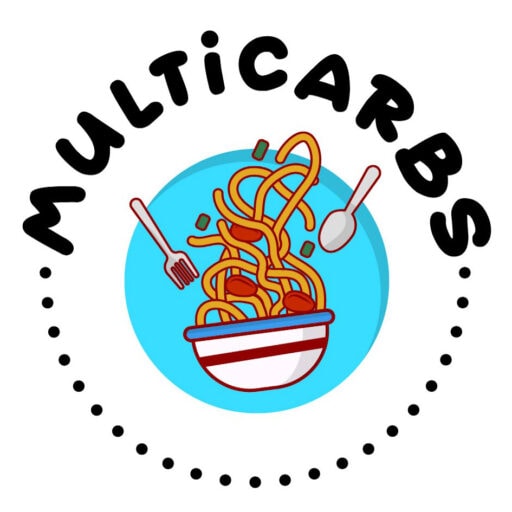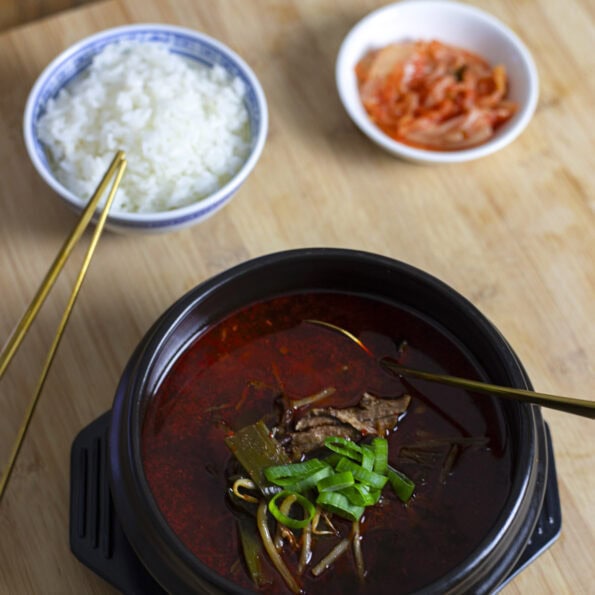
Yukgaejang (Spicy beef soup)

![건고사리 Gosari Fougère Comestible Séchée 100G [Assi] DDM 31.12.2025](https://acemartmall.com/cdn/shop/products/gosari-fougere-comestible-sechee-100g-assi_4d76fbd3-c6b0-405f-96c0-e43d3ce3246c_1024x1024.jpg?v=1663240569) While I tend to prefer fermetend-based soups, which add a nice depth of flavour, I must say that simpler soups like Yukgaejang make for a nice change, with a more direct and cleaner taste. It could also be a good entry point for those who are not familiar with Korean soups and stews !
This soup is also perfect for those who watch their weight and care for their health ; fiber-rich, low in fats with the use of lean meat, Yukgaejang is absolutely perfect to feel like you're indulging when you're actually not.
While I tend to prefer fermetend-based soups, which add a nice depth of flavour, I must say that simpler soups like Yukgaejang make for a nice change, with a more direct and cleaner taste. It could also be a good entry point for those who are not familiar with Korean soups and stews !
This soup is also perfect for those who watch their weight and care for their health ; fiber-rich, low in fats with the use of lean meat, Yukgaejang is absolutely perfect to feel like you're indulging when you're actually not.
Yukgaejang - Recipe
Ingredients - Advice & key points
- Gosari :
- Fear not, if you cannot find some dried gosari at your favourite Korean grocery store, you'll be able to easily order it online !
- Do account for the fact that you need to soak your gosari at least 6 hours (ideally overnight).
- You can buy pre-soaked gosari, but careful : you don't want to buy sweet, seasoned gosari that's used for Bibimbaps or Gimbaps.
- The other Korean ingredients are common ; you'll have no trouble finding them at your usual Asian or Korean grocery store.
- Meat :
- I use short ribs here, which are a tad more fatty, but a popular cut for Yukgaejang is brisket.
- You want your meat to be quite tender, but it won't be pull-apart tender like pulled pork, for example.
- If you can take a bit of heat, but not much, just halve the gochugaru amount. I do not recommend skipping it altogether, as you might find the stew a bit lacking in taste. If you don't want a spicy stew, wait up, I'll soon post non-spicy stew recipes !
Cooking and eating Yukgaejang
- You don't need to use a Dolsot like I do. The cool part about Dolsots is that they retain the heat well, so your Kimchi Jigae will remain piping hot as you eat it. But simply use any pot you have ; I'm sure it won't turn real cold, because you will devour this dish in no time !
- It is nice to eat some side dishes (banchans) to go with your Yukgaejang. If you're brave enough, you could cook 1 or 2 vegetables banchans along with it, such as simple spinach, bean sprouts or cucumber ones. I simply tend to buy them from the Korean mart -because they are delicious !
- I often eat my Yukgaejang with rice and kimchi only, and it's absolutely pleasurable.
A spicy yet delicate beef-based stew, with earthy flavours from gosari and shiitakes.
- 500 grams beef (brisket or short ribs)
- 8 spring onions (if thin, add 10)
- 40 grams dried gosari (~170g rehydrated)
- 4 dried shiitake mushrooms
- 3 liters water (1L = 4 cups)
- 1 medium onion
- 200 grams mung bean sprouts
- 8 garlic cloves
- 1 teaspoon salt
- 1/4 cup gochugaru
- 2 teaspoons salt
- 1 tablespoon soy sauce
- 1 tablespoon toasted sesame oil
- 1 tablespoon neutral oil
- Soak your gosari
Soak your gosari at least 6h or overnight.
- Start cooking your beef
Cut the beef in smaller pieces along the grain. Soak in cold water for around 15mn, wash & drain.
Meanwhile, halve the onion and bring 3L of water to a boil in a large pot.
Add the beef, the dried shiitake mushrooms, the onion, and the salt.
Cook 1h30 over medium high heat. Skim off the scum with a skimmer after 10-15mn.
- While the beef cooks
Cook the soaked gosari 50 minutes (taste after 30 minutes ; if it's soft, remove). Halve it when done.
Cut the green onions in 4 cm pieces, and mince your garlic. Add to a bowl with the mung bean sprouts and gosari.
Prep the seasoning paste by mixing all the ingredients together. Cover with cling film.
- Finish this stew
When the beef is done, add the seasoning paste to the veggies bowl. Mix well.
Remove the beef, onion and mushrooms from the broth. Let the beef and mushrooms cool down and discard the cooked onion.
Add the veggies mixture to the boiling soup and cook 10 minutes over medium-high heat.
Add the sliced mushrooms and torn apart beef. Cook another 10 minutes.
Serve with rice and banchans if you wish.
Et voilà !! You're done !
Thank you for trying out this recipe ! Do not hesitate to leave some feedback. I hope it brightened your day.